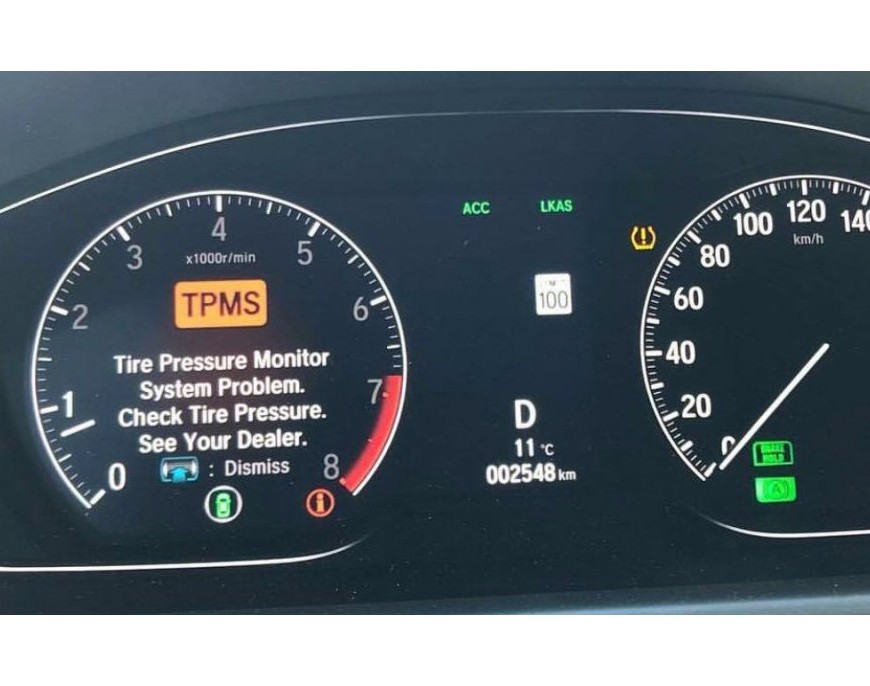All you should know about car TPMS.
What is the TPMS light?
The TPMS light is a dashboard alert that lets you know when one or more of your tires is under-inflated. Depending on your vehicle, tire pressure is monitored either by your ABS system or by a battery-powered sensor mounted on each wheel or tire. Your Tire Pressure Monitoring System is an important safety feature because under-inflated tires pose an increased blowout risk. TPMS is also a cost-saving feature because low tire pressure shortens tire life. An under-inflated tire wears down prematurely at the edges.
What services are available for the TPMS system?
Different TPMS systems have different repair and service options. For instance, most TPMS sensors do not have removable batteries, so the entire sensor must be replaced when the battery is drained. Here are the TPMS service options at Midas:
Tire inspection to rule out slow leaks as a cause of tire under-inflation.
Diagnostic check (and servicing) of TPMS system1.
Replacement seals and nuts on TPMS sensors (TPMS Service Kit).
TPMS sensor battery testing.
TPMS sensor replacement, installation, and programming.
TPMS reset after tire service.
Why is my TPMS light on?
A steady TPMS light usually means one or more of your tires is under-inflated. Depending on your vehicle, various pressure conditions may trigger a TPMS alert, such as a sudden change in pressure, or your tire pressure falling too low by a certain percentage. A blinking or flashing TPMS light usually indicates an issue with the TPMS system itself, such as a dead TPMS sensor battery. Check your vehicle manual to learn what triggers your particular TPMS light.
Why is the TPMS light still on?
If you’ve added air to your tires and verified their inflation levels with a tire pressure gauge, there are three possible reasons for the TPMS light to stay on:
Your TPMS needs resetting: Some sensors require a TPMS reset after adding air as well as rotating or replacing tires. Check your vehicle manual for the procedure.
Your TPMS needs service: Likely if the light is blinking and your verified tire pressure is stable.
A slow tire leak: Likely if the TPMS light is steady after adding air. Keep monitoring tire inflation. If your verified tire pressure drops too quickly, it’s time for tire repair.
Is it safe to drive with the TPMS light on?
It is only safe to drive with the TPMS light on if you’re certain your tires are maintaining proper pressure (suggesting the light is on because of a TPMS system issue). It’s unsafe to drive on improperly inflated tires, so check your tires with a pressure gauge as soon as your TPMS light comes on. If your tires maintain correct pressure but the light still won’t go off, it’s time for diagnostic service on your TPMS. In this case, it’s OK to drive in the short term, as long as you monitor your tire pressure carefully -- and remember that you may not be reliably alerted to dangerous changes in tire pressure.
Does TPMS need to be replaced?
A TPMS sensor is typically replaced when its battery runs out. Very few sensors come with removable batteries, so the lifespan of a TPMS sensor is usually equal to its battery life.
Do I need to replace TPMS when replacing tires?
You don’t need to replace your TPMS sensors when buying new tires, but it’s often convenient to do so if the sensors are more than a few years old. Most TPMS sensor batteries last five to ten years, so older sensors may not last as long as your new tires. Many drivers prefer to avoid the hassle of replacing TPMS sensors mid-way through the tire lifecycle.
Midas recommends a TPMS Service Kit when replacing tires. This kit contains replacement parts for the sensor’s valve stem seals and nuts to ensure a perfect fit to your new tires.
Your local Midas technician can help you decide whether to replace TPMS sensors based on the life expectancy of your new tires, and we’ll be here to replace your sensors when the time is right.
Should I have the TPMS reset after replacing tires?
You should always reset your TPMS after changing or rotating tires, or installing new sensors. Some sensor manufacturers recommend resetting it even after adding air to your tires. Resetting the TPMS is often described as retraining the main TPMS system by teaching the system to recognize the sensors in their new positions. Depending on your vehicle, the TPMS reset procedure consists of a sequence of ignition and pedal movements, changing a setting in your dashboard menu, or using a TPMS Reset Tool.
Check your vehicle manual or ask your local Midas technician how to reset your TPMS after tire service.













